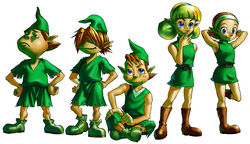Difference between revisions of "Kokiri"
m |
(→Trivia) |
||
| Line 22: | Line 22: | ||
=Trivia= | =Trivia= | ||
| − | *The Kokiri wardrobe consists of variations on Link's traditional cap and tunic. It seems that this was intended to be the origin of Link's costume, but | + | *The Kokiri wardrobe consists of variations on Link's traditional cap and tunic. It seems that this was intended to be the origin of Link's costume, but this was undone when other ''Zelda'' games were established to take place prior to this game featuring Link wearing the green tunic. |
=See Also= | =See Also= | ||
Revision as of 02:21, 22 June 2018

| |
| Mido and several other Kokiri children. | |
| Kokiri | |
| Origin | Kokiri Forest |
| Type | Elven folk |
| Debut | The Legend of Zelda: Ocarina of Time |
The Kokiri are a group of forest children (also referred to as "fairy folk") who primarily appear within The Legend of Zelda: Ocarina of Time.
Information
Little is known about the Kokiri's origin, except that they were created by the Deku Tree and sheltered within Kokiri Forest. Kokiri are incapable of aging and remain pointy-eared children forever. They wore green tunics, with males having pointed caps while females wore headbands. Most of them are appointed guardian fairies and told that they will die if they leave the forest, although the exact implications of this are unknown given events later in the game. The Kokiri had their own small village within Kokiri Forest and even ran a shop. Their treasure was the Kokiri's Emerald, one of the Spiritual Stones from Hyrule's Royal Family, but only the Deku Tree seemed to be aware of it. The Link who would become the Hero of Time was brought to the Deku Tree as a baby and was raised as one of the Kokiri. Link was considered an outcast by his peers, including Mido, the self-proclaimed leader of the Kokiri. The kindly Saria was always quick to defend him.
Link started to gain acceptance from the others when he was finally assigned a fairy named Navi. But around that time, Ganondorf infected the Deku Tree in an attempt to get the Kokiri's Emerald and caused its death. While Link was able to retrieve the Kokiri's Emerald at the Deku Tree's urging, Link was the only one to witness the Deku Tree's death and hear its last words. Mido and the other Kokiri assumed that Link had killed the Deku Tree and shunned him even more. Saria defended Link's reputation after he left the forest. Over the seven years of Ganondorf's reign, the forest was infested with monsters. The Kokiri had to live in fear, and Saria was trapped within the Forest Temple. With Link's help following his return, the Forest Temple was liberated and the forest became safer again. Saria was awakened as the Sage of the Forest and became the Kokiri represented among the sages, and a the Deku Tree was reborn as a sapling. The other Kokiri did not recognize Link as an adult, but most of them, Mido included, felt bad about the way they had treated the young Link. After Ganondorf's defeat, the Kokiri were seen attendiing the festivities at Lon Lon Ranch (lending doubt to the belief that they would die if they left the forest).
In The Wind Waker, it was shown that following the Great Flood, the Kokiri had changed into plant-like creatures called Koroks. They still lived under the protection of the Great Deku Tree. The only actual Kokiri to appear in the game was the ghost of Fado, the Wind Sage whom had been killed by Ganondorf.
Trivia
- The Kokiri wardrobe consists of variations on Link's traditional cap and tunic. It seems that this was intended to be the origin of Link's costume, but this was undone when other Zelda games were established to take place prior to this game featuring Link wearing the green tunic.